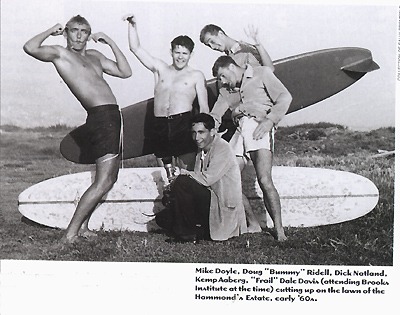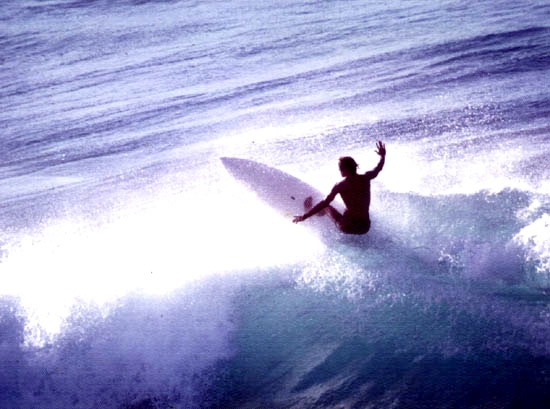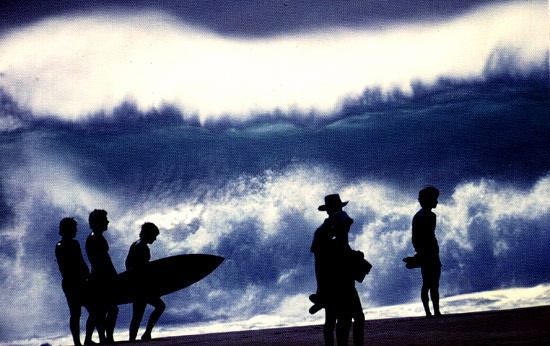This
is a film about a nearly forgotten sub-generation,
a small but culturally distinct group consisting
of the babies born during the war. Forming the
last separate cultural group before the baby
boomers, they are very different from those of us
born a few years earlier or later. They were
neither part of the do-wop/rockabilly era nor the
age of the Beatles. The children born between 1941
and 1945 were all between 14 and 18 on February 3,
1959, which means that they were all of the kids
sitting in high school classes on "the day the
music died," the day Richie Valens, Buddy Holly
and the Big Bopper died in the crash of a private
plane. Not surprisingly, Don McLean was conceived
during the war, was in high school that day, and
later raised that memory to the level of a
cultural myth. Elvis entered the army in 1958, the
the Big Three crashed down in 1959, so do-wop was
dead or dying and the Beatles were four years in
the future. It was the era of the folk craze, and
the surf-'n'-car classics. California, or at least
the romance of California, took the cultural lead
for the first time in memory.
When
those war babies went to college, the world really
hadn't changed much since the Eisenhower years. In
other words, the war babies missed "the 60s"
completely. Oh, some of them graduated as late as
1967, but the period of time which we now remember
as "the sixties" - the anti-war movement, the
protests, the campus revolts, the hippie days, the
cultural revolution - had not yet begun. That era
actually started in the summer of 1967 and lasted
until Nixon resigned in the summer of 1974. Some
people say it ended earlier, that the 1972
McGovern campaign was really the last significant
gathering of The Movement. Maybe so. The point is
this - if you graduated from college in 1967, as
the last of the war babies did, your school years
completely missed the entire period we now know as
the 60's. Your graduation day may have been seven
years into the decade, but the era was still
waiting to be defined.
When
the baby boomers arrived at the universities,
everything changed dramatically. To those of you
who were not there, I can't convey how dramatic
the shift was at a certain point in time. The
change was revolutionary, not evolutionary. I
started college in 1966, with the old rules in
place, in an Eisenhower world. The last war babies
were still there as seniors, and I got to
experience their world for a quarter of my college
time. We had to sign in and out of our dorms. No
women or alcohol were allowed in the rooms. We had
a monitor living at the end of the hall. We wore
ties to class. We had beer blasts and panty raids.
When the last war babies graduated in the summer
of 1967, everything changed immediately. The world
went crazy in that summer between my freshman and
sophomore years. By Thanksgiving of sophomore
year, we had essentially no rules at all, campus
buildings were in flame, and the administration
was terrified. At that point, the administrators
would have been happy to let us go back and have
those women and kegs in the dorms, because that
would have taken our minds off the drugs and the
violent riots. The change was really that abrupt:
June 1967 in the beer-drinkin' Eisenhower world,
November 1967 in the drugged-out anti-war hippie
haze.
The
story of the baby boom generation is writ bold
across the cultural landscape, and sung oft in
popular minstrelsy, but there have not been so
many voices, nor such loud ones, to tell the tale
of the war babies. Big Wednesday is the
unofficial sociological summary of the coming of
age period for the cultural icons of the small and
forgotten sub-generation that came before the
resounding baby boom. Writer/director John
Milius was born during the war and, in the
haziness of hindsight, defined the romance of
surfing as the iconographic glue that held
together the sub-generation or war babies.
Searching for the perfect wave was not just their
recreation, but their spiritual quest. Just as the
pre-war babies had Elvis, and the boomers had The
English Invasion, the war babies had The Beach
Boys. Milius was definitely an insider in that
culture. He was a friend of many of the famous
surfers, and went to USC from 1962-1967, almost
exactly concurrent with the era of those beach
party movies which seemed like quaint, irrelevant
relics just a year or so after Milius graduated.
Milius loved surfing so much that he even found an
improbable but memorable way to work it into his
script for Apocalypse Now.
The
first half of Big Wednesday is episodic, and the
episodes are based on actual events, or at least
the mythological versions of those events,
from the lives of the legendary surfers from that
golden era. (See the article below this one for
details.) It's light comedic froth which seems
amusing but pointless. Three friends surf
together, have wild parties, and live their
carefree youth in the California Dream. A girl
from the Midwest says, " ... it's so
different here. Back home, being young is just
something you have to do for a while before you
grow up. Here it's everything." That's part of
what the war baby generation was all about -
avoiding adulthood and adult concerns as long as
possible. One of the characteristics that marked
the war babies as culturally distinct from their
successors is that they were content to live as
adolescents in an adult-centered world. Before the
combination of the draft and the Vietnam War came
along and made geopolitics personal, there were
not a lot of young Americans interested in global
events, so surfing makes an excellent metaphor for
their disassociation from the grave concerns of
the adult world.
The
second half of Big Wednesday is more dramatic, and
concentrates more on the nature of friendship. The
Vietnam War comes along and brings a grim reality
into the surfers' lives. One of the best episodes
is their induction physical, a comedic vignette
which demonstrates just about every draft-evading
scam used in those days. The dramatic conclusion
of the film creates its title. Big Wednesday was
an actual day during The Great Swell in 1974 when
record 20 foot waves hit Southern California. The
three friends, their lives long since gone in
separate directions, reunite for that day to test
themselves once more against giant waves.
Surfline.com says that Big Wednesday is the one
and only time when Hollywood ever nailed down
the culture of surfing and its tiny
sub-generation. Probably so. My late
friend Dale Davis, a famed surfing filmmaker who
was a true insider in that culture, felt the
same way. (See below for my interview with him
made shortly before his death in 2001.) The
movie itself is picaresque, and only a so-so
movie, but it is worthwhile, if only to
understand the pop culture landscape of the
forgotten war baby generation.
TRIVIA:
William Katt and
his mom, Barbara Hale, played son and mother in
the movie.
William Katt and
Jan-Michael Vincent were actually ardent surfers
who did some of their own board work in the
movie. (That was not them on the 20 foot waves,
however). Gary Busey wasn't a surfer, but he
learned enough to lend credibility to the film.
|
The Boys of
(Endless) Summer
|
Big Wednesday is
based on real people and their stories.
Dale Davis, the legendary surfing
cinematographer, was present at many of
the events portrayed in the movie, and
even filmed some of the original events as
they happened. Dale is the
producer/director of such surfing classics
as Inside Out, in which he filmed
the largest wave ever ridden; The
Golden Breed, in which he portrayed
the everyday life of the surfing crowd,
both on and off the waves; and Walk on
the Wet Side, an early film which
featured the specific group of surfers
pictured in Big Wednesday.
Scoop:
Dale, how do you know about the events
in Big Wednesday?
Dale: I
was there, at least for the events in
the first half of the movie. There was a
house in Santa Barbara called the
butterfly house because it was on
Butterfly Lane. It was a bunch of
surfers. I filmed some parties there and
in one case, I even filmed the real
version of an event recreated in the
movie. If you remember the scene where
Jan-Michael Vincent went out with a cape
on Highway 101, started bullfighting
with the cars, and caused an accident
... that was actually done by a surfer
named Lance Carson, and I filmed the
original event in 16mm!
|
 |
 |
Scoop: So the Vincent role was based
directly on Lance Carson?
(pictured left)
Dale: No, not exactly. The three
guys in the movie were based on
several real surfers, the first group
of surfers ever to become nationally
famous, especially Lance Carson, Doug
"Bummy" Ridell, Mike Doyle, Mickey
Dora, Bob Cooper, and The Masochist.
The events in their lives, however,
are composites, so that there isn't a
one-to-one correspondence between the
characters and real people. The
Jan-Michael Vincent role is mostly
based on Lance, especially the
drinking, but it was actually Mike
Doyle who got out of the army because
of the surf bumps on his knees. The
doctor had never seen surf bumps
before, and Mike exaggerated his. He
made them swell by hitting them with a
piece of wood in the Selective Service
parking lot.
For the most part, William
Katt's role is probably closest to a
guy named Bob Cooper, who was a
straight-arrow guy. The surfers were a
mixed group of guys. Some partied all
the time, some didn't drink at all.
Cooper was an intellectual who would
read James Joyce in between waves.
Some of Cooper's personality also
appeared in the movie character called
The Bear.
|
Do you remember the guy who
pretended to be gay to avoid the
draft? That was supposedly based on
Miki Dora, who may have been the
craziest of them all. The last anybody
heard of him, he was imprisoned in
Africa for stealing diamonds. Or maybe
he just started that rumor himself. He
was crazy enough to do the crime, but
he was also crazy enough to make up
the story, so who knows? One day I ran
into him when he had been handcuffed
to a fence by some cops during some
craziness. He asked me to get him a
hairpin, and eventually set himself
free before the cops came back to get
him! He wrote "Dora Rules" out there
everywhere - on piers and steps and
pylons and pretty much every place he
could think of along the beach. They
tell me that some of the "Dora Rules"
graffiti is still out there after all
these decades.
The Gary Busey character,
"The Masochist", is a combination of
"The Bumkin" Ridell and a guy who
really was called The Masochist. They
were both from San Francisco. The
real-life Masochist did get in the
oven, as pictured in the film. I know
that for sure, because I turned it on
for him! The director, John Milius,
also added a little bit of Lance
Carson to that character, because it
was actually Lance who used the
insanity ploy to avoid the draft.
There were some funny events
that didn't make the movie. Lance,
especially, was a source of crazy
stories. I remember driving along one
time, getting pulled over by a cop,
and I didn't know why. Turns out it
was because Lance pissed on the cop
car out of the back of our
convertible.
Good memories. We'd meet at 5
in the morning at the restaurant
pictured in the early scene. It was
called something like the L.A. County
Store and Restaurant, run by a stern
old Scottish woman. Those guys would
surf from sunup to sunset many days.
They often surfed in wet suits,
because the surf temperature could get
pretty low, but I guess that wasn't
sexy enough for the film.
|
 |
There were other events in
the movie, in the later years, that
I don't know about. The film has a
post-Vietnam reunion in the
graveyard, for example. I just don't
know how closely that part followed
reality, because I wasn't hanging
with them then.
Scoop: What happened to those
guys?
Dale: Lance Carson straightened
out and quit drinking, but he stayed
close to surfing. I heard he now
makes surfboards here in California.
Doyle is now a ski instructor in
Colorado. Dora I mentioned. Cooper
is in Queensland, Australia, and
eventually had something like nine
kids. Bummy and Masochist, I don't
know because they were from Northern
California, and I lost track of
them.
(Photograph to the left,
and the one of Lance Carson above,
by Dale Davis)
|
DVD INFO
widescreen
anamorphic, 2.35:1
full-length
commentary by John Milius
|
NUDITY
REPORT
|
|
None.
Rated PG
|
|
|
|
